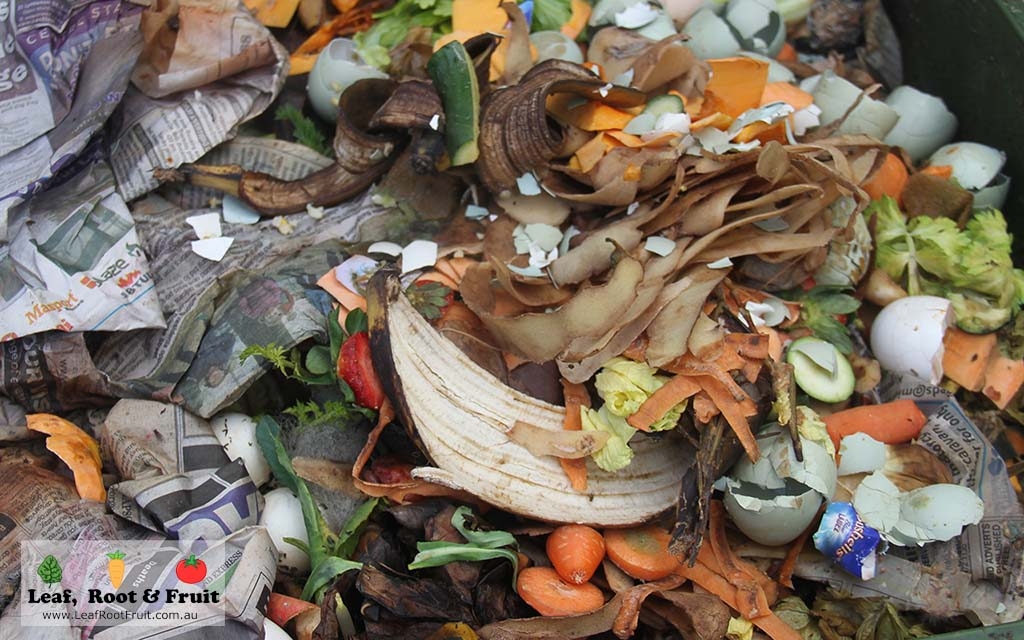
Households can produce large amounts of organic waste. Composting can be a great way to reduce your household contribution to landfill and create a useful product for your garden. The way to improve most soils, regardless of whether they are sandy, heavy clay or somewhere in between, is to add organic matter, and compost is the best type of organic matter to add.
Good soil is teeming with microbes, fungi, protozoa and arthropods. It’s a complex, living structure that provides most of the nutrients for you plants. You are what you eat, and your plants are no different. Good compost can help increase and support life in your soil. It will increase the nutrient density of your fruit and veggies and will make them healthier for you and to taste better.
Carbon and Nitrogen: The Key to Great Compost
Everything living is predominantly made of carbon and nitrogen. Once a living thing dies, it starts to break down. The rate and effectiveness of decomposition is determined by the ratio of carbon and nitrogen within that material (and its immediate surrounds).
The key to great composting is getting the ratio of carbon and nitrogen correct. Ideally it is in the region of 25:1 carbon to nitrogen). If you add materials to your compost heap to obtain roughly that ratio then it will break down quickly and create a nice form of compost. Read more about this and “The Stinky Test” below.
Composting Problems and How to Fix Them
There are two main symptoms we can look for when diagnosing compost problems:
Compost is too dry and not breaking down.
You might find that your compost is dry and potentially full of ants. Generally, dry composts take a long time to break down. The reason for this is that the carbon : nitrogen ratios are out of balance and there is too much carbon in the compost. Usually this is caused by adding too many sticks and other coarse matter to the compost.
To correct this problem, add more nitrogen to the compost!
Compost is a wet, stinky sludgy mess
Compost should smell nice. If it stinks it is likely to be anaerobic and proliferating microbes that are not so great for your garden. Adding oxygen can help improve the situation but it is best to prevent the issue in the first place. The reason for a wet, stinky form of compost is that there is too much nitrogen, often due to too many kitchen scraps being added without coarse carbon-based materials.
To correct this add more carbon to the compost!
Use “The Stinky Test” To Work Out What Is Carbon Based And What Is Nitrogen Based.
Nothing is purely carbon or purely nitrogen. So working out a perfect 25:1 carbon to nitrogen ratio is impossible to do on paper. It’s something that you need to practice, observe and get a feel for. Using the guide to the two main problems of composting will help you to quickly identify issues and correct them.
There are plenty of charts that you can look up with the proposed carbon to nitrogen ratios for many types of organic matter. They are a great general guide. Well-meaning family and friends may tell you that nitrogen-based materials are green (such as lawn clippings) and that carbon-based materials are brown (such as autumn leaves). However, the green / brown rule is not always true.
To get a rough idea of what is high in carbon and what is high in nitrogen you can do the stinky test. We recommend that you just imagine doing the test, but you could actually do the test if you really wanted to!
The Stinky Test
Step One: Fill a bucket with water
Step Two: Add the material in question to the bucket
Step Three: Sit aside for a week before analysing results
Analysing results:
Smell the resulting concoction in the bucket
- If the resulting concoction is very smelly after a week… the material is high in nitrogen
- If the resulting concoction doesn’t have much of a smell… the material is high in carbon
As mentioned above, you don’t need to actually do the stinky test, just imagine it.
For example, if you added some fish heads, lawn clippings, or veggie scraps to the bucket then it would stink because all of those things are high in nitrogen.
If we added a lump of timber, wood chips or shredded newspaper to the bucket, then it is likely that it won’t stink. This is because those things are high in carbon.
Just by imagining the stinky test you should be able to balance the carbon and nitrogen ratios in your compost. It will also help you to work out what materials you could add to your compost to fix the two main composting problems listed earlier.
What Are Your Reasons For Composting?
There are two main reasons people identify for wanting to compost:
- To reduce waste going to landfill
- To create a resource for improving soil
For most suburban situations, unfortunately, one single compost system will not fully meet the needs of both reasons to compost. A suburban household generally does not produce enough food scraps to generate compost for a medium to large sized garden. So, alternative compost solutions will be required to keep the garden topped up, full of nutrients and organic matter.
To help you decide which compost solutions are best for you I have put together this chart. Note, more than one compost solution may be required, to meet your household needs.
Composting Solutions For The Home Gardener To Consider
Chickens
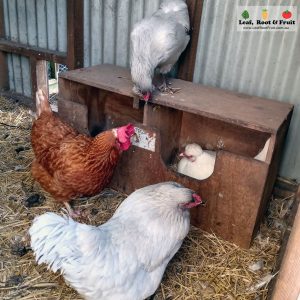
For those with enough space, chickens are the ultimate composting solution. A well-designed chicken run can make composting a breeze. Your chooks will turn scraps into protein rich eggs. Throw all your weeds, and garden waste into the run and let them turn it (literally…. with their feet) into a nitrogen rich compost to add back to the garden. Chicken manure performed very well (in small doses) in my soil conditioner trial.
Pros:
- Eggs!
- Feathered friend antics are fun to watch
- The chooks will do all the work – so you don’t have to
- Can be useful pest controllers in the garden (but only for short periods of time – chooks and veggie gardens don’t mix well)
Cons:
- You need a well designed and constructed chook run with straw yard to keep your girls safe from foxes
- Chickens can attract rodents, sparrows and other vermin, although good practices can minimize or even completely prevent this
- You’ll need someone to mind them if you go on holidays for more than one or two nights
Hot Compost
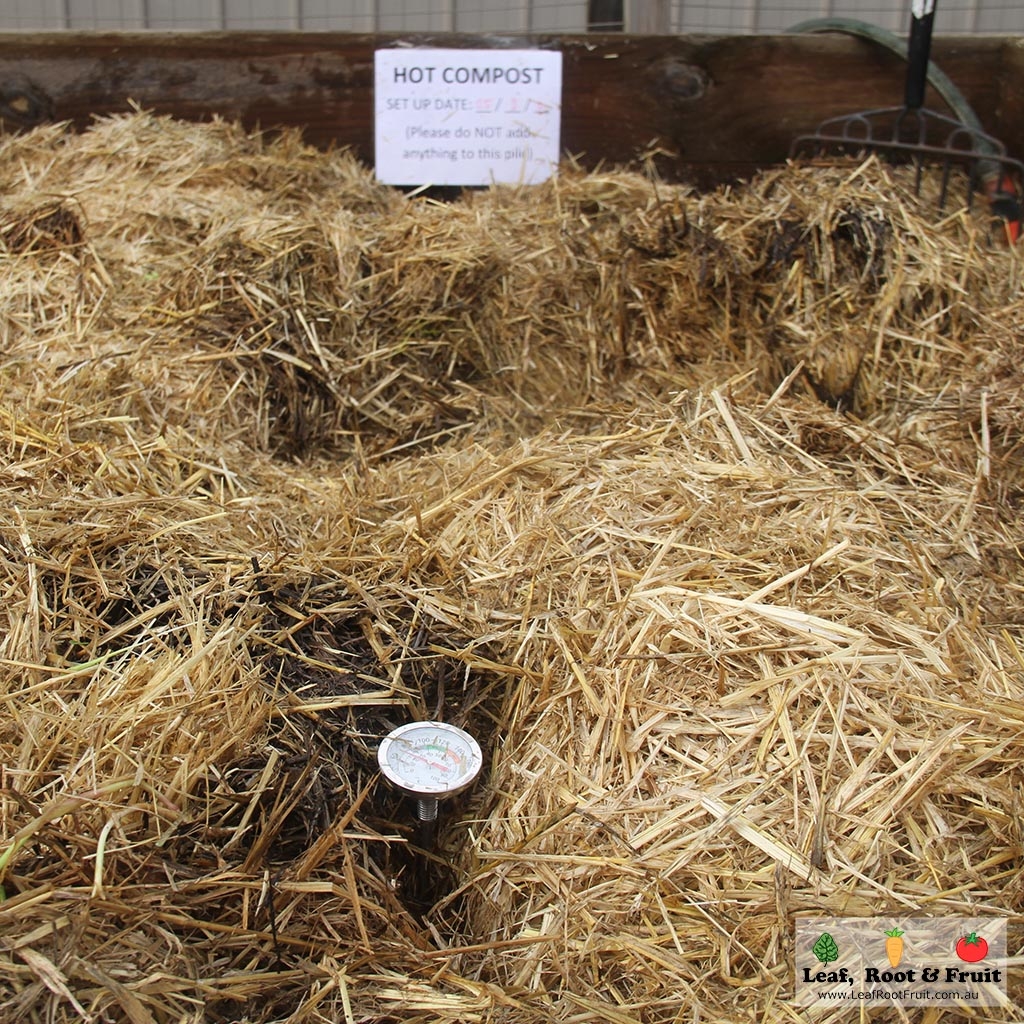
Hot composting is great for generating large amounts of compost. As organic material breaks down, it releases heat as an exothermic reaction. Check out this post on thermal imaging in the garden to get an idea of the heat generated. This heat has the benefit of:
- Speeding up the decomposition process
- Sterilizing most weed seeds
- Killing most pathogens and bad microbes that may be present.
Provided you keep the temperature below 70 degrees Celsius, many of the good microorganisms should survive the hot composting process.
There are a few rules worth following when hot composting:
- You must have a minimum of 1 cubic metre in volume: anything smaller than this and the heat will dissipate too quickly and the temperature won’t reach the desired 65 to 70 degrees.
- Source all of your materials and build it all at once. It is not a bay that you continually add material to over time (that’s cold composting)
- You need to have lots of water and air available within the compost to aid in decomposition. Use light fluffy carbon sources such as straw or autumn leaves to increase air. Have someone dedicated to watering the compost while it is being built.
- The carbon and nitrogen ratios must be roughly 25:1
Construction of a Hot Compost is a bit like making a no dig or lasagna garden bed. You alternate layers of carbon rich then nitrogen rich materials.
Check out this video I made for more information. It includes a time lapse of us building a Hot Compost. Although you’ll probably spend most of your time watching the antics of our 3 year old “helping” build the compost.
Pros:
- Can be big enough to supply compost for the whole garden and can be pre planned
- It can be a fun activity to do with family or friends (and then share in the resulting compost at the end)
- It only takes up space for 4 to 12 weeks, then it can be spread around the garden
Cons:
- It is not suitable for dealing with kitchen scraps all year round and you cannot gradually add to it
- You need to have enough materials on hand to build it
- Alternatively, you can buy the straw and manures etc to build the hot compost, but we have found it’s cheaper to just buy ready-made compost instead!
Worm Farms
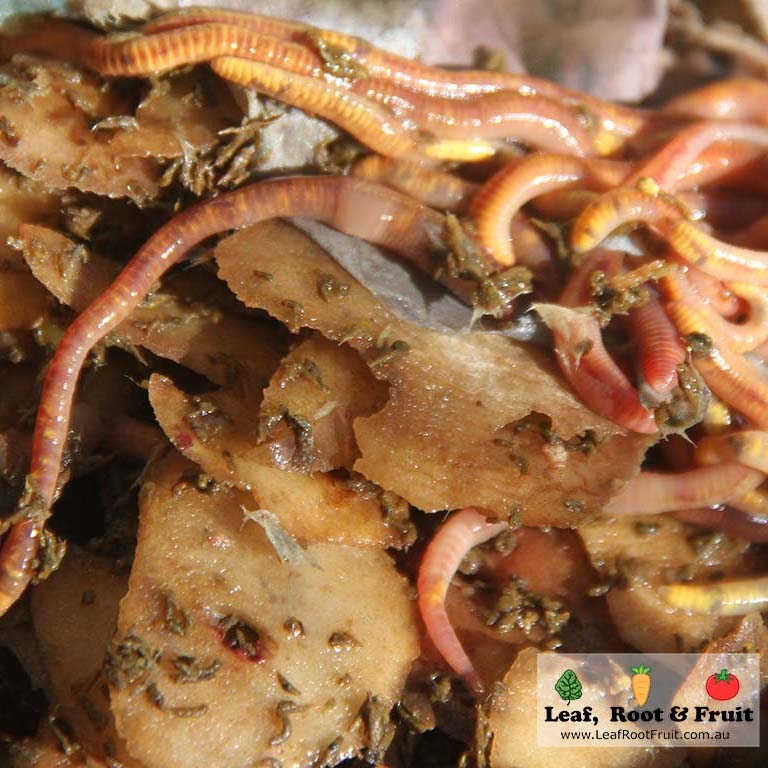
A well set up worm farm can be great for diverting veggie scraps from landfill. A worm farm turns veggie scraps into worm castings much more quickly than cold composting will. Worm castings (worm poo) is great for the garden as shown in our soil conditioner trial. The worm wee is reported to be a great soil conditioner. However, in my fertilizer trial Ifound that it wasn’t very effective at promoting plant growth.
A few tips for worm farms:
- Avoid placing your worm farm where it receives direct sun as you will cook the worms in summer. Instead find a shady spot to position the worm farm
- Avoid using black plastic worm farms, as they heat up very quickly in direct sun
- Many of the available worm farms involve multiple tiers that must be changed when full. They become a bit confusing for folks new to worm farming. I recommend the Hungry Bin Worm Farm as it avoids this issue. The large volume within the worm farm helps reduce heat stress in summer. It’s quite easy to use, although harvesting the worm castings from the bottom of the bin can be challenging. Fortunately, you only need to do this a few times per year.
- You can create a great worm farm out of an old bath. Just make a decent lid to go on top to keep rodents out.
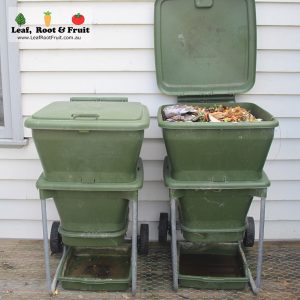
Pros:
- Great for small spaces
- Very nutrient rich castings are great for the veggie patch
- Rodent proof (usually)
- Faster break down than standard cold composting
- Carbon nitrogen ratios are mostly irrelevant
Cons:
- Some set ups, such as the Hungry Bin can be relatively expensive
- You need a shady spot to ensure your worms don’t get cooked in summer
- Not great for composting onions, citrus and meat scraps
Bokashi
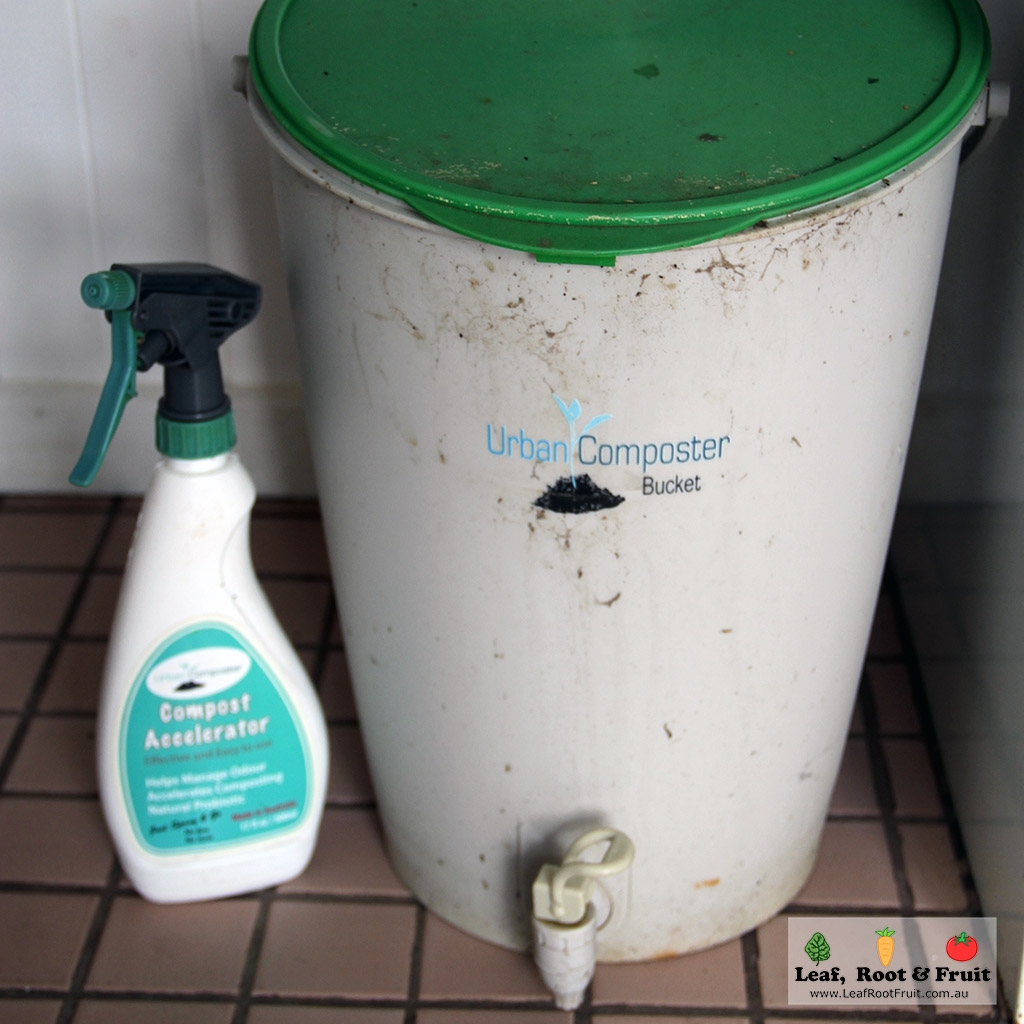
Bokashi is not actually composting, it is more like fermentation of waste. Bokashi set ups are simple, usually a bucket with a tap to drain the juice from the bottom and a lid. There are commercial options to buy or you can easily make your own.
Pros:
- Can fit under the kitchen bench
- Doesn’t smell
- Add anything that was once living (including citrus, onions and meat)
- Carbon and nitrogen ratios are irrelevant
Cons:
- Can only produce a small volume
- Acidic product so needs composting before adding to garden
- Need to purchase enzymes to spray contents every time new material is added
Compost Tumblers
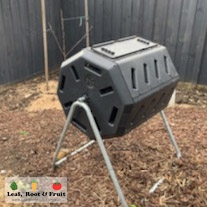
Compost tumblers are quite popular due to their compact, rodent proof design and the ease with which the compost can be turned. They encourage good air flow and in theory can make great compost. However, more often than not I see them filled with an excess of nitrogen-based materials and despite the good airflow, they stink. One of the downsides of compost tumblers is the small volume of material they can handle. I also believe that good compost should be made in contact with existing soil to enable the good microbes to inoculate (a bit like a yogurt culture). Compost tumblers are great for some situations but a bit of a gimmick, I’d prefer a worm farm any day.
Pros:
- Ergonomic: resulting compost can usually be unloaded straight into the wheel barrow
- Easy to turn
- Good airflow
- Rodent proof (usually)
Cons:
- Can be expensive, for what they are
- Can often only handle small volumes of organic matter
- Still requires carbon and nitrogen ratios to be followed
Rat Hotels
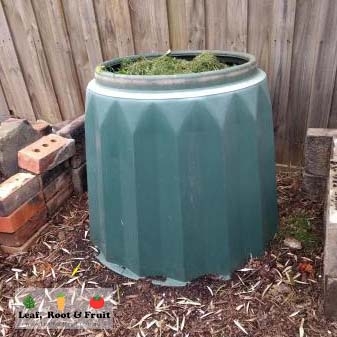
These bins are cold compost systems. They are popular because they are cheap.
The Theory….
Cheap to buy (you can usually find them in hard rubbish easily enough). Place them somewhere in the garden and they are good to go. Take the lid off, throw your kitchen scraps and lawn clippings in and they begin to compost.
The compost is in contact with the soil so the worms and microbes can infiltrate from underneath. The nutrients can seep out into the soil, feeding the surrounding areas. In a few months pull the bin up and off the compost, shovel the goodness onto the garden and start the process again.
The Reality…
Take the lid off, throw your scraps to the family of rats that have tunnelled in underneath and set up residence in your compost bin. Inside is a dry, protected and warm home for them. Plus you deliver food as part of the daily room service. Once your veggies and fruit trees start to produce they’ll make nightly excursions from their home to devour your crops and frustrate you endlessly. How I loathe the typical bottomless compost bin!
You can fit rodent proof mesh to the base to keep the rats out. However, I’ve also seen them chew holes in the bin itself to get back into their cosy homes. Adding rodent mesh to the bottom would make extracting the finished compost a challenge.
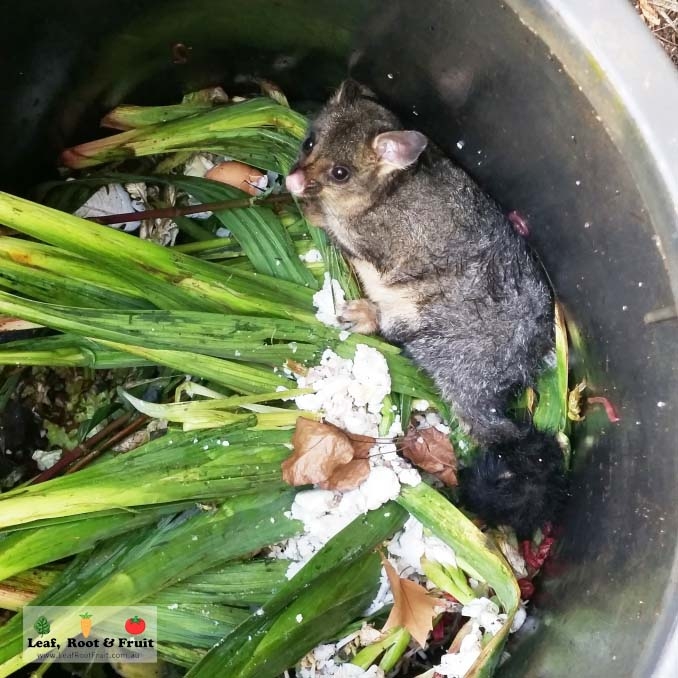
Pros:
- Very cheap
- Suits a small space
- Easy to empty finished compost
Cons:
- Rodents
- Requires carbon and nitrogen ratios to be followed
Aerobins
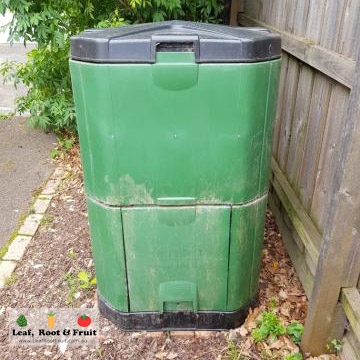
I don’t have much experience with these systems, mainly due to the cost factor. Those that have them, swear by them. Aerobins increase airflow through the compost to quickly break down organic matter. It is still a Cold Compost system, but in theory, it will break down organic matter as quickly as a Hot Compost. They are certainly more rodent proof than the typical bottomless rat hotel compost system.
Pros:
- Breaks down compost very quickly
- Doesn’t require turning
Cons:
- Expensive
- Requires carbon and nitrogen rations to be followed
Mowing the grass in autumn
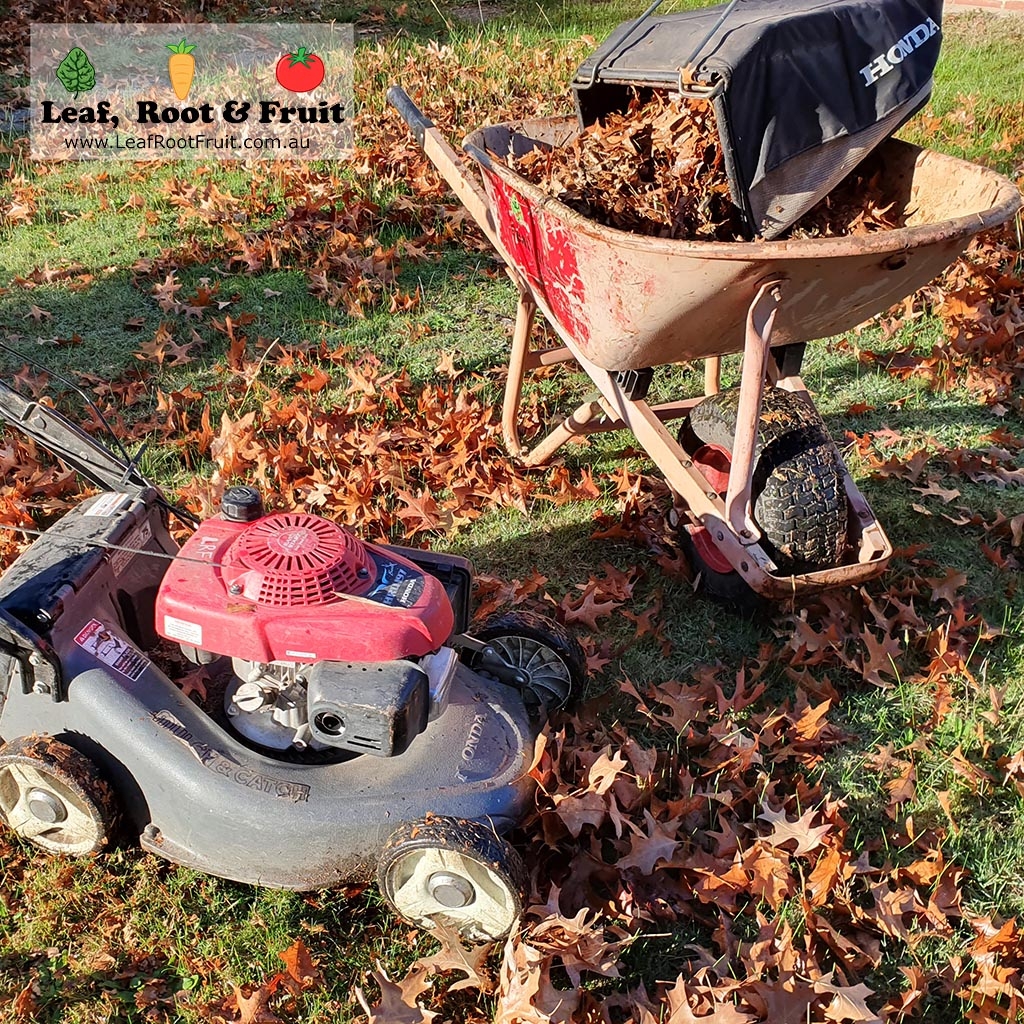
Fresh green grass clippings combined with shredded autumn leaves makes a good base mix for compost. It is a great balance of carbon and nitrogen. Instead of raking up the leaves, simply run the lawn mower over them, mowing the grass at the same time. The mower does the shredding and mixing for you. It also vacuums it all up ready to add to your compost pile.
Mowing the leaves and grass together, first thing in the morning, (or just after it rains) means that the result is already sufficiently damp to promote rapid composting. However, the mower can quickly clog under these conditions. Pile this mix up and let it do its thing for a few months. This is the easiest compost ever. You could even use a rat hotel to keep the mix as there are no food scraps to attract rodents.
Pros:
- Carbon and Nitrogen ratios taken care of
- Free materials
- Very little work required
Cons:
- Needs lots of lawn and deciduous trees (or your own gardening company)
- Season specific
Worm Towers
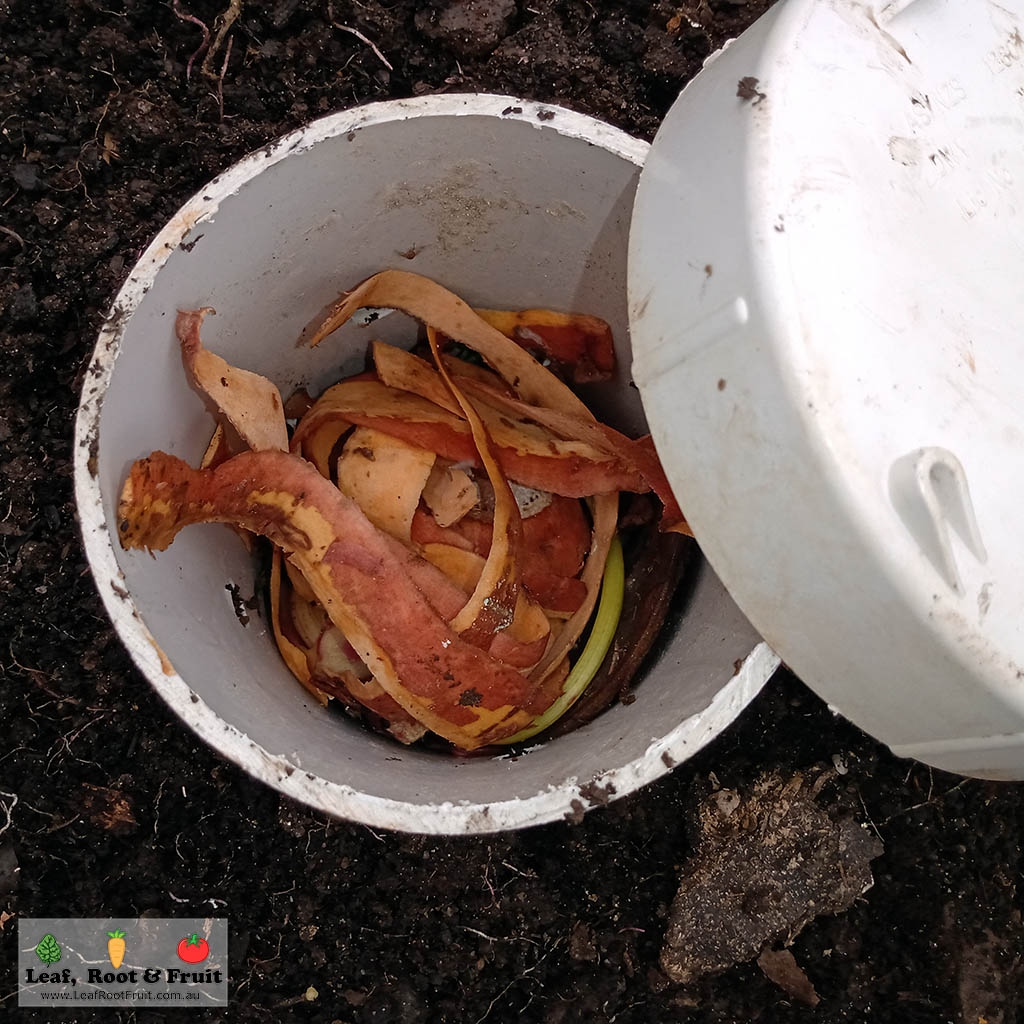
Worm towers are a great way for small households to manage their kitchen scraps. They are easily made by drilling some holes or cutting some slits into some PVC storm water pipe. Bury the pipe vertically in your veggie garden. Add some veggie scraps and place a lid on top to keep rodents out. Keep the veggie scraps topped up as you generate them. Worms will naturally migrate into the worm farm to feed and then distribute the nutrients straight into your garden bed. Worm towers are cheap to make and can be a very effective composting solution for those with small gardens.
Pros:
- No need to follow carbon and nitrogen ratios
- Easy to use – no need to empty compost onto the garden – it’s already there!
- Very cheap and easy to make
Cons:
- Best to avoid onions, citrus and meat
- Compost worms don’t generally burrow into the soil. They stay on the soil surface where there is lots of organic matter. So i’m not sure how effective they are.
- Can only handle small volumes per worm tower, so you may need a few
- Compost cannot easily be used in other parts of the garden
- PVC pipe can leach vinyl chloride (a known carcinogen) into the soil when it is damaged via drilling
Mushroom Compost
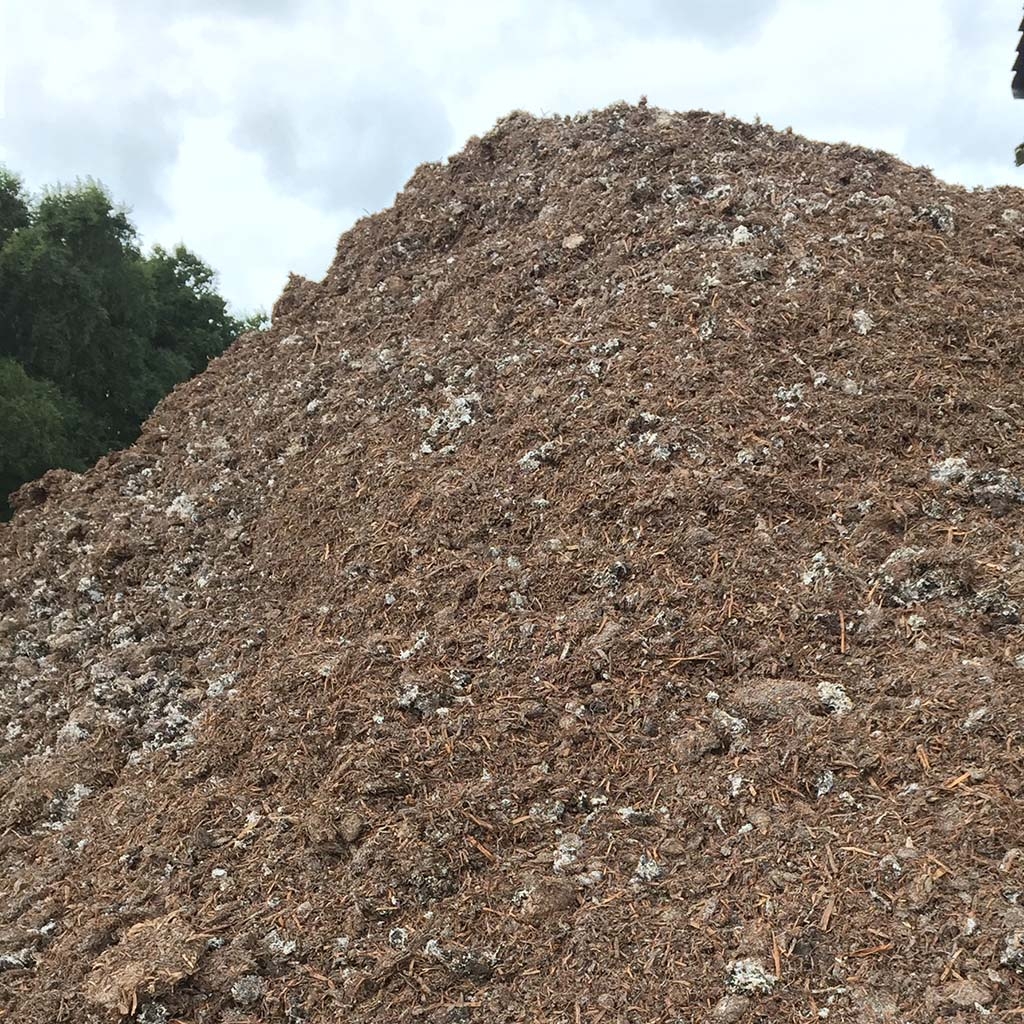
If you have a large garden space that needs some addition of compost, then one of the best options is to buy some ready-made compost from a garden supplies centre. I usually opt for mushroom compost as I generally get good results from the I use.
Mushroom compost has a bad reputation in some online forums, particularly due to variable and often highly alkaline pH. I think the confusion and bad reputation is because there are different types of mushroom compost out there:
Real Mushroom Compost: Has been carefully formulated for mushroom growth. It has been sterilised prior to inoculation with mushrooms, to enable the one species of fungi to proliferate. This sterilisation has also sterilised any potential weed seeds or pathogens. The mushroom compost supports mushroom growth for a few weeks which is noticeable as large amounts of fluffy white mycelium through the substrate. This mushroom compost is awesome and will really give your plants a nutrient boost.
Mushroom Compost that has never been used to grow mushrooms: Years ago I paid less attention to who supplied my mushroom compost. I found that some garden supplies would deliver a load of “compost” that had obviously never been used for growing mushrooms. Often it looked just like (barely) composted wood chips and green waste. I believe that it is this type of “mushroom compost” that has given the product a bad reputation of variable pH and poor performance.
I now only order mushroom compost from a select few garden supplies. If you are looking to order some for yourself then I urge you to inspect the compost prior to purchase. Look for the tell tale white mycelium through the compost. If it doesn’t have it, then don’t buy it. Price is also a fairly good indicator of quality when it comes to compost.
Pros:
- No space required for a compost system
- Great results with good product
- Relatively cheap
Cons:
- Requires finding a good supplier – not all products sold as mushroom compost have been used to grow mushrooms
- Doesn’t involve processing your own kitchen scraps
The Final Verdict On Compost Systems
Chooks are the ultimate compost solution, but not everyone has the space (or inclination) for chooks.
To divert vegetable scraps from landfill try a worm farm, but this probably won’t generate enough compost for a reasonable sized vegetable patch of a few square metres or more.
To generate enough compost for your veggie patch then try setting up a hot compost every year, or order in some mushroom compost (first make sure that it has been used to grow mushrooms)
How do you use compost in the vegetable patch?
Check out Using Compost in the Vegetable Patch in my Vegetable Patch from Scratch series to make sure you are using your precious compost to maximise productivity of your patch.
One Final Composting Tip....
Two common problems with composting kitchen scraps:
- They are high in nitrogen which can lead to smelly compost issues
- The small bin or container you keep in the kitchen to take the scraps out to the compost in gets slimy and dirty. So your intermediate container requires regular cleaning
A ridiculously easy solution to this is to take one sheet of newspaper (the local rag is perfect for this) and line the container with that. Next time you empty the scraps, empty the sheet of newspaper with it. The container will be left clean and you will have balanced the nitrogen rich scraps with the carbon in the paper.
Please note: I do not receive any payment, free products or other incentives for mentioning any of the products featured in this blog.
Want To Know More About Composting?
Leaf, Root & Fruit run a series of workshops called “The Science of Edible Gardening“. The August workshop “Carbon and Nitrogen Cycles: The Science of Compost” covers all things compost. See my events page for upcoming workshops, and sign up to my newsletter to be notified of future events.
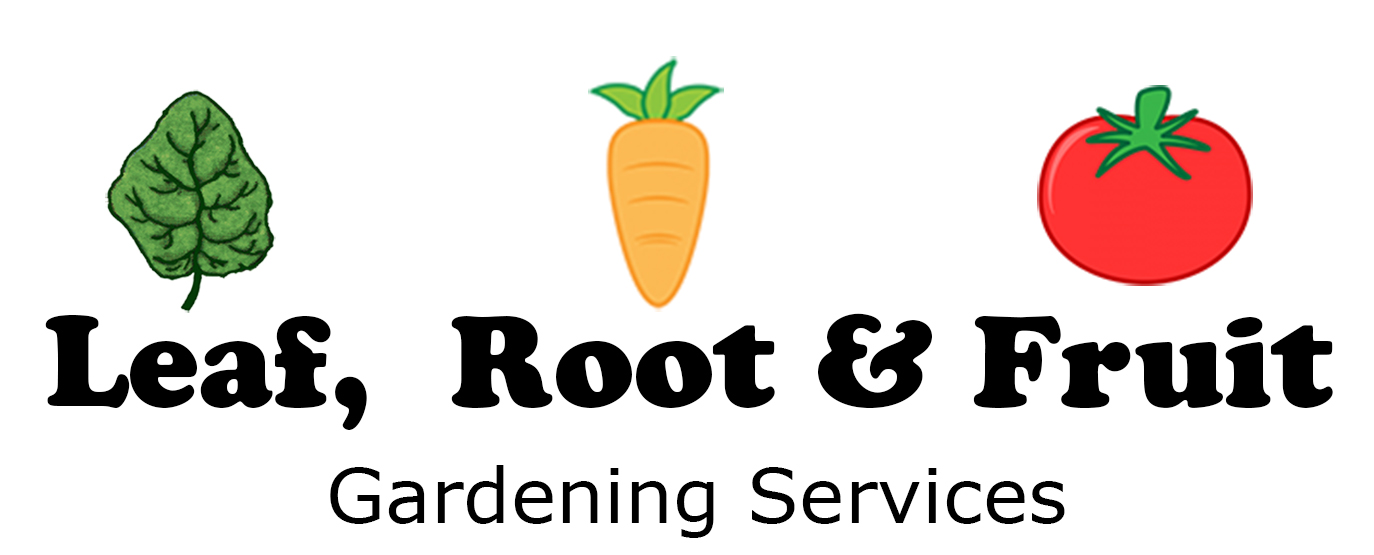
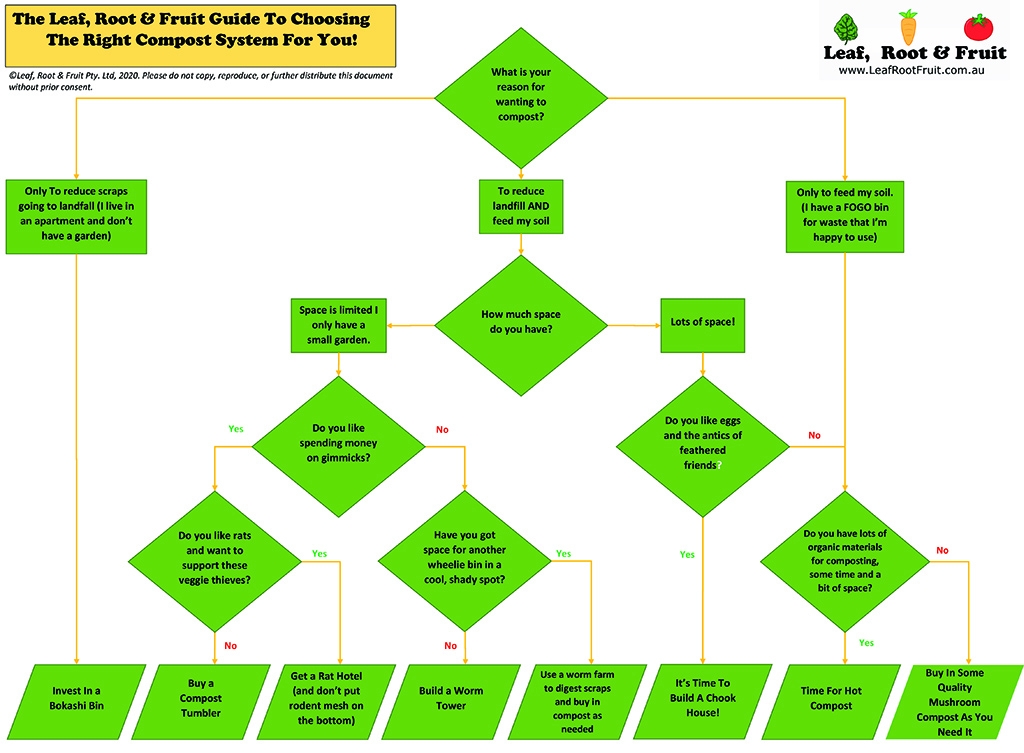

Thank you so much for this very comprehensive report.
We have a decent sized suburban backyard, no chooks, no local newspaper anymore even.
We generate a fair amount of kitchen scraps and I feel guilty putting them in the garbage bin. However I won’t try composting at home again. In the past I have tried worm farms and bokashi buckets but they didn’t work for me.
I believe that for a metropolitan area the already used system in some areas of the local council collecting food waste in a separate bin or in the green waste bin and then composting it en mass would be best. Unfortunately the municipality I live in is not very forward thinking. Instead they persist in subsidising bins of different kinds and running workshops on composting.
Hi Jennifer,
Thanks for your feedback. Hopefully in the long run, you establish a system that works for you.
Good Luck & Happy Gardening!
Hi Duncan, I bought a cubic m of mushroom compost from Fultons as you suggested. I don’t know what white mycelium? is supposed to look like, but I’ve shoveled half of it and nothing white appears to be in it; looks like horse manure is in it. Is it bad for the garden if it’s not right and what do I do in that case. Or do I trust that Fultons delivered good stuff?
cheers Esther (Moorabbin)
I already get your emails re not ticking the box below.
Hi Esther,
If the mushroom compost is fresh you should be able to see the white mycelium fairly easily. If it has been sitting around for a while (eg in the sale yard or after delivery to your place) then the white may have deteriorated. I know there have been issues with supplies of mushroom mulch this year, so the product may not be “the usual” and instead be a similar substitute. We haven;t used Fulton’s much in the last 6 months.
Good Luck & Happy Gardening!
Duncan
Hi, great article. I had a question. If unfortunately your heap goes anerobic and gets stinky and slimy all the info on various sites books etc says it will produce bad bugs and toxins that are no good for the garden. Ok fair enough but does that mean you have to Chuck it or can it be retrieved by adding carbon? I guess my question is what happens up the toxins?
Thanks
Glenn
Hi Glenn,
I’d just add more carbon, aerate it well and it should convert to something great! I wouldn’t throw it out.
Good Luck & Happy Gardnening!
Duncan
Hi Duncan,
Thank you for all this useful information. Unfortunately Covid preventing me from attending your worshop but this is a great substitute.
I think the best method for me is the worm tower but I’m concerned about the vinyl chloride contamination.
Do you know how significant this is and does it dissipate fairly quickly?
I’m also considering ordering some mushroom compost.
Is it ok to plant straight into it? Could you use it as potting mix??
Thanks again,
Michele
Hi Michele,
It’s a pity you couldn’t attend… hopefully next year!
Like most contamination, it’s all about risk assessment. There’s no hard data saying that if you put PVC in the soil that it will leach x amount into the soil, meaning that your plants will uptake y amount and you will therefore ingest z amount. In short you need to make your own informed decision on that one. If it does leach, what is the likelihood of you ingesting it? If you do ingest it, what is the potential risk? Often these questions only have theoretical answers. Healthy soil with a thriving soil food web should help to break down most contaminants over time.
Mushroom compost is not potting mix. It is predominately organic matter that will settle and break down quickly. Many plants will have roots that are sensitive to this rich compost. So I wouldn’t advise it as potting mix. Instead check out our page on potting mix for some ideas on what to use.
Good Luck & Happy Gardening!
Duncan